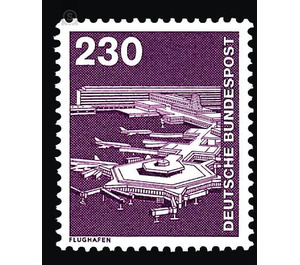Postage stamp: industry and technology - Germany / Federal Republic of Germany 1979 - 230 Pfennig
Theme: Architecture
| Country | Germany / Federal Republic of Germany |
| Issue Date | 1979 |
| Face Value | 230.00 |
| Color | violet |
| Perforation | K 14 |
| Printing Type | Typography |
| Stamp Type | Postage stamp |
| Item Type | Stamp |
| Chronological Issue Number | 881 |
| Michel ID | BRD 994 |
| Chronological Chapter | GER-BRD |
| SID | 670324 |
| In 65 Wishlists | |
Supplement to the 1975/76 introduced postage stamp series "Industry and Technology". The 230 Pf value appears simultaneously and identically with the inscription Deutsche Bundespost Berlin. The postage stamp shows the passenger terminal of the Frankfurt airport, which was opened in March 1972. Rhein-Main, founded in 1936, has developed over the past decades into a hub of international aviation. Frankfurt ranks tenth in passenger traffic worldwide and even fourth in air freight traffic. In 1978, Frankfurt registered almost 16 million passengers, over 605,000 tonnes of air freight and 69,000 tonnes of airmail. This means that Rhein-Main is No. 2 in Europe in terms of passenger volume and even No. 1 in air freight and airmail. The number of take-offs and landings in 1978 rose to around 216,000. The proportion of wide-body aircraft is constantly growing. More than 50 Jumbo Jets Boeing 747s, McDonnell Douglas DC-10s, Airbus A-300s and other widebody aircraft are handled daily at this airport. Frankfurt alone offers almost 4,800 connections a week to 190 cities in 90 countries. Almost every second passenger changes the aircraft on Rhein-Main. Frankfurt guarantees an unparalleled transfer time of only 45 minutes for long-haul airports. One of the preconditions for this is the electronically controlled baggage handling and sorting system, which automatically transports the suitcases of up-and-down passengers to the right jet. The special importance of Frankfurt in world air transport is explained by its central geographical location in the heart of Central Europe, its excellent access to the motorway and rail network, but also the efficiency of this airport with its modern technical facilities and sophisticated organization of operations. Rhein-Main is the home base of Deutsche Lufthansa and the hub of its route network spanning the globe. Well over 30,000 people are employed at Frankfurt Airport. It can be stated without exaggeration that Frankfurt Rhein-Main is a city in itself. In the terminal complex, in which including the transport links around 1 billion marks have been invested, there are nearly 130 different shops and restaurants, 3 cinemas and a large nightclub. Likewise, a clinic staffed around the clock is just as lacking as a dental practice, a pharmacy, a clergyman, a forester, a police station and its own main customs office. Integrated into the terminal are an underground car park and a parking garage for a total of 7,000 passenger cars. From the airport train station, 12 meters underground in front of the terminal, the passenger arrives in 12 minutes in the Frankfurt city center. Even long-distance trains go to the Jumbo Station. (Text: Frankfurt Main Airport, Frankfurt am Main)
| Condition | Name | In Stock | Price | Price + Shipping | Store | |
|---|---|---|---|---|---|---|
 | Used | Postage stamp: industry and technology - Germany / Federal Republic of Germany 1979 - 230 Pfennig | 1 | US $0.385 | N/A |  Utestamps (0) Utestamps (0)Request a Shipping Quote Minimum Lot Average US $1.91 |


